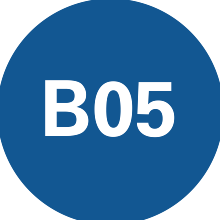People
Research Project B05 plans to cooperate closely on image-based characterisation and physical investigation of fractured rock with the group of Jens Birkholzer and Seiji Nakagawa at Lawrence Berkeley National Laboratory (LBNL, Berkeley).
A lively exchange of principal investigators and doctoral researchers between Berkeley and Stuttgart has existed for many years, especially in the field of fractured porous media systems. Recently LBNL has built an advanced laboratory for investigating the physics of hydraulic fracturing.
Publications
(Journal-) Articles
- Krach, D., Ruf, M., & Steeb, H. (2025). POREMAPS: A finite difference based Porous Media Anisotropic Permeability Solver for Stokes flow. InterPore Journal, 2, Article 1. https://doi.org/10.69631/ipj.v2i1nr39
- Shokri, J., Ruf, M., Lee, D., Mohammadrezaei, S., Steeb, H., & Niasar, V. (2024). Exploring Carbonate Rock Dissolution Dynamics and the Influence of Rock Mineralogy in CO2 Injection. Environmental Science & Technology, 58, Article 6. https://doi.org/10.1021/acs.est.3c06758
- Wachsmann, S. B., Ruf, M., Prinz, C., Oehlsen, N., Zhou, X., Dyballa, M., Arweiler, C., Leistner, P., Steeb, H., Garrecht, H., Laschat, S., & Stegbauer, L. (2024). Chitin/Chitosan Biocomposite Foams with Chitins from Different Organisms for Sound Absorption. ACS Sustainable Chemistry & Engineering, 12, 11879–11890. https://doi.org/10.1021/acssuschemeng.4c00044
- Wang, J., Sonntag, A., Lee, D., Xotta, G., Salomoni, V. A., Steeb, H., Wagner, A., & Ehlers, W. (2024). Modelling and simulation of natural hydraulic fracturing applied to experiments on natural sandstone cores. Acta Geotechnica, 19, 7709–7725. https://doi.org/10.1007/s11440-024-02351-7
- Lee, D., Weinhardt, F., Hommel, J., Piotrowski, J., Class, H., & Steeb, H. (2023). Machine learning assists in increasing the time resolution of X-ray computed tomography applied to mineral precipitation in porous media. Scientific Reports, 13. https://doi.org/10.1038/s41598-023-37523-0
- Ruf, M., Lee, D., & Steeb, H. (2023). A multifunctional mechanical testing stage for micro X-ray computed tomography. Review of Scientific Instruments, 94. https://doi.org/10.1063/5.0153042
- Schmidt, P., Steeb, H., & Renner, J. (2023). Diagnosing Hydro-Mechanical Effects in Subsurface Fluid Flow Through Fractures. Pure and Applied Geophysics, 180, 2841–2860. https://doi.org/10.1007/s00024-023-03304-z
- Taghizadeh, K., Ruf, M., Luding, S., & Steeb, H. (2023). X-ray 3D imaging-based microunderstanding of granular mixtures: Stiffness enhancement by adding small fractions of soft particles. Proceedings of the National Academy of Sciences of the United States of America, 120. https://doi.org/10.1073/pnas.2219999120
- Kurzeja, P., & Steeb, H. (2022). Acoustic waves in saturated porous media with gas bubbles. Philosophical Transactions of the Royal Society A, 380. https://doi.org/10.1098/rsta.2021.0370
- Lee, D., Karadimitriou, N. K., Ruf, M., & Steeb, H. (2022). Detecting micro fractures: a comprehensive comparison of conventional and machine-learning-based segmentation methods. Solid Earth, 13, 1475–1494. https://doi.org/10.5194/se-13-1475-2022
- Schmidt, P., Jaust, A., Steeb, H., & Schulte, M. (2022). Simulation of flow in deformable fractures using a quasi-Newton based partitioned coupling approach. Computational Geosciences, 26, 381–400. https://doi.org/10.1007/s10596-021-10120-8
- Erfani, H., Karadimitriou, N. K., Nissan, A., Walczak, M. S., An, S., Berkowitz, B., & Niasar, V. (2021). Process-Dependent Solute Transport in Porous Media. Transport in Porous Media, 140, 421–435. https://doi.org/10.1007/s11242-021-01655-6
- Gao, H., Tatomir, A. B., Karadimitriou, N. K., Steeb, H., & Sauter, M. (2021). Effects of surface roughness on the kinetic interface-sensitive tracer transport during drainage processes. Advances in Water Resources, 157. https://doi.org/10.1016/j.advwatres.2021.104044
- Wagner, A., Eggenweiler, E., Weinhardt, F., Trivedi, Z., Krach, D., Lohrmann, C., Jain, K., Karadimitriou, N., Bringedal, C., Voland, P., Holm, C., Class, H., Steeb, H., & Rybak, I. (2021). Permeability Estimation of Regular Porous Structures: A Benchmark for Comparison of Methods. Transport in Porous Media, 138, 1–23. https://doi.org/10.1007/s11242-021-01586-2
- Yiotis, A., Karadimitriou, N. K., Zarikos, I., & Steeb, H. (2021). Pore-scale effects during the transition from capillary- to viscosity-dominated flow dynamics within microfluidic porous-like domains. Scientific Reports, 11. https://doi.org/10.1038/s41598-021-83065-8
- Hasan, S., Niasar, V., Karadimitriou, N. K., Godinho, J. R. A., Vo, N. T., An, S., Rabbani, A., & Steeb, H. (2020). Direct characterization of solute transport in unsaturated porous media using fast X-ray synchrotron microtomography. Proceedings of the National Academy of Sciences of the United States of America, 117, 23443–23449. https://doi.org/10.1073/pnas.2011716117
- Konangi, S., Palakurthi, N. K., Karadimitriou, N. K., Comer, K., & Ghia, U. (2020). Comparison of Pore-scale Capillary Pressure to Macroscale Capillary Pressure using Direct Numerical Simulations of Drainage under Dynamic and Quasi-static Conditions. Advances in Water Resources, 147. https://doi.org/10.1016/j.advwatres.2020.103792
- Ruf, M., & Steeb, H. (2020). An open, modular, and flexible micro X-ray computed tomography system for research. Review of Scientific Instruments, 91. https://doi.org/10.1063/5.0019541
- Hasan, S. N., Joekar-Niasar, V., Karadimitriou, N., & Sahimi, M. (2019). Saturation-Dependence of Non-Fickian Transport in Porous Media. Water Resources Research, 55, 1153–1166. https://doi.org/10.1029/2018WR023554
- Karadimitriou, N. K., Mahani, H., Steeb, H., & Niasar, V. (2019). Nonmonotonic Effects of Salinity on Wettability Alteration and Two-Phase Flow Dynamics in PDMS Micromodels. Water Resources Research, 55, 9826–9837. https://doi.org/10.1029/2018wr024252
- Steeb, H., & Renner, J. (2019). Mechanics of Poro-Elastic Media: A Review with Emphasis on Foundational State Variables. Transport in Porous Media, 130, 437–461. https://doi.org/10.1007/s11242-019-01319-6
- Yin, X., Zarikos, I., Karadimitriou, N. K., Raoof, A., & Hassanizadeh, S. M. (2019). Direct simulations of two-phase flow experiments of different geometry complexities using Volume-of-Fluid (VOF) method. Chemical Engineering Science, 195, 820–827. https://doi.org/10.1016/j.ces.2018.10.029
- Zhang, H., Frey, S., Steeb, H., Uribe, D., Ertl, T., & Wang, W. (2018). Visualization of Bubble Formation in Porous Media. IEEE Transactions on Visualization and Computer Graphics, 25, 1060–1069. https://doi.org/10.1109/TVCG.2018.2864506
Published data sets
- Fauser, D., Rodríguez Agudo, J. A., & Steeb, H. (2024). Direct and Indirect Measurement of Complex Poisson’s Ratio - Indirect Measurement in Torsion and Tension [DaRUS]. https://doi.org/10.18419/DARUS-3590
- Fauser, D., & Steeb, H. (2024). Direct and Indirect Measurement of Complex Poisson’s Ratio - Direct Measurement in Tension [DaRUS]. https://doi.org/10.18419/DARUS-3588
- Krach, D., Ruf, M., & Steeb, H. (2024). POREMAPS 1.0.0: Code, Benchmarks, Applications [DaRUS]. https://doi.org/10.18419/DARUS-3676
- Madadi, H., Fauser, D., & Steeb, H. (2024). Direct and Indirect Measurement of Complex Poisson’s Ratio - Direct Measurement in Compression [DaRUS]. https://doi.org/10.18419/DARUS-3593
- Lee, D., Ruf, M., Yiotis, A., & Steeb, H. (2023). Numerical investigation results of 3D porous structures using stochastic reconstruction algorithm [DaRUS]. https://doi.org/10.18419/DARUS-3244
- Lee, D., & Steeb, H. (2023). Image enhancement code: time-resolved tomograms of EICP application using 3D U-net [DaRUS]. https://doi.org/10.18419/DARUS-2991
- Lee, D., Weinhardt, F., Hommel, J., Class, H., & Steeb, H. (2023). Time resolved micro-XRCT dataset of Enzymatically Induced Calcite Precipitation (EICP) in sintered glass bead columns [DaRUS]. https://doi.org/10.18419/DARUS-2227
- Ruf, M., Lee, D., & Steeb, H. (2023). In situ performed fracturing experiment of a limestone sample using an X-ray transparent triaxial cell: micro-XRCT data sets and measurement data [DaRUS]. https://doi.org/10.18419/DARUS-3106
- Ruf, M., Lee, D., Yiotis, A., & Steeb, H. (2023). micro-XRCT datasets of stochastically reconstructed 3D porous media micromodels manufactured by additive manufacturing [DaRUS]. https://doi.org/10.18419/DARUS-3243
- Ruf, M., Taghizadeh, K., & Steeb, H. (2023). micro-XRCT data sets and in situ measured ultrasonic wave propagation of pre-stressed monodisperse rubber and glass particle mixtures with 10%, 20%, 40%, and 60% volume rubber content: sample 1 [DaRUS]. https://doi.org/10.18419/DARUS-3436
- Ruf, M., Taghizadeh, K., & Steeb, H. (2023). micro-XRCT data sets and in situ measured ultrasonic wave propagation of pre-stressed monodisperse rubber and glass particle mixtures with 10%, 20%, and 30% volume rubber content: samples 2 and 3 [DaRUS]. https://doi.org/10.18419/DARUS-3437
- Ruf, M., Taghizadeh, K., & Steeb, H. (2022). micro-XRCT data sets and in situ measured ultrasonic wave propagation of a pre-stressed monodisperse rubber and glass particle mixture with 30% volume rubber content [DaRUS]. https://doi.org/10.18419/DARUS-2833
- Jaust, A., & Schmidt, P. (2021). Replication Data for: Simulation of flow in deformable fractures using a quasi-Newton based partitioned coupling approach [DaRUS]. https://doi.org/10.18419/DARUS-1778
- Ruf, M., Taghizadeh, K., & Steeb, H. (2021). micro-XRCT data sets and in situ measured ultrasonic wave propagation of a pre-stressed monodisperse rubber and glass particle mixture with 50% volume rubber content [DaRUS]. https://doi.org/10.18419/DARUS-2208
Research
About this project
The aim of this project is to characterize fractures and fracture networks based on a combination of physical experiments, image-based methods, and numerical simulations. The focus of all the investigations lies on the fundamental understanding of hydromechanical coupling effects of (deformable) fluid-saturated fractures embedded in a deformable porous material. Project B05 aims at providing the scientific community with detailed information and further insight into i) the development and evolution of preferential flow paths in fracture networks, ii) the role of asperities in the non-linear effective hydromechanical coupling between fractures, iii) the possibility of back-analyze the fracture properties in the case of non-linear hydromechanical coupling, iv) the role of leak-off in crystalline rocks, and v) whether the same concepts can be applied on fractures saturated with more than one fluid phase.
Results
For the performance of image-based characterization and in-situ XRCT investigations, the existing experimental facilities at the Porous Media Lab (PML) have been substantially enhanced. We have successfully developed and applied a new X-ray transparent cell, also used in synchrotron studies. This cell allows the characterization of multi-phase/multi-component flow processes in porous materials under controlled confining stress conditions, by applying a confining pressure. Additionally, an X-ray transparent triaxial cell for stress states up to 20 MPa has been designed and successfully implemented into our XRCT in situ set-up. In this new triaxial cell the triaxial stress states, and the confining/pore pressure can be individually controlled, offering the ability to employ bigger rock samples (diameter of ¼ inch). Surfaces of cores can be prepared (e.g. grinded and accurately polished) and even miniaturized strain gauges can be implemented due to the bigger size. The open XRCT device was also upgraded with a 10 kN uniaxial testing device for mechanical in situ experiments. In order to tackle the ring artefacts due to unresponsive detector pixels, we implemented a method to slightly shift the detector’s position and combine the acquired information to account for the lost information.
For the investigation of complex fracture networks, we quenched (gradual increase and sudden decrease of temperature) a Bianco Carrara marble. The corresponding samples were characterized with standard techniques for their effective properties before and after treatment. Additionally, the topology of the fracture network was investigated with μ-XRCT. For the effective characterization of the fracture network, the segmentation the μ-XRCT data had to be performed. In order to compare the segmentation efficiency, we adopted three conventional segmentation methods and two machine learning segmentation methods. For the conventional segmentation methods, the application of a data noise reduction technique before segmentation was essential for the success of the process. That was not necessary in the machine learning schemes, which eventually saves computation time. However, given that the training of the machine learning model required excessive memory, the images were diced into small tiles in order to avoid a memory limitation issue. The U-net machine learning scheme was proven to be the most effective approach to segment the μ-XRCT data.
The in-house developed Digital Rock Physics (DRP) workflow was also employed to complement the experimental approach with XRCT-based Stokes simulations for large REVs (up to10003 voxels. An explicit high performance Stokes solver has been developed and it is currently being tested for voxel-based geometries XRCT scans.
We also focused on the hydro-mechanical coupling in a fracture. A numerical investigation was performed which was able to reproduce a non-linear relation between flux and pressure caused by a volume change, under a harmonic pressure-/flow stimulation of a single fracture under confining stress. Under the same conditions, a benchmark experiment was conducted on an aluminum sample with rough fracture surfaces. This artificial fracture was stimulated with a harmonic flux of a fluid via an induced bore hole and the corresponding induced pressure was measured. As a way to show the non-linearity in the relation between flux and pressure under a harmonic stimulation, we present the measured corresponding pressure in the frequency domain. In both the numerical and experimental investigation, overtones were observed which imply the non-linear response of the system.
However, an artificially induced fracture may hold different properties such as storativity, diffusivity and contact stiffness, from natural fractures. For further realistic investigation of the harmonic stimulation on a single fracture, we introduced a single fracture in a sandstone sample by hydraulic pressure. Performing the harmonic experiment on this realistic sample is ongoing work.
Microfluidic investigations have also been performed in order to understand the hydromechanical interaction of “soft” fractures embedded in Poly-di-methyl-siloxane (PDMS) We investigated the intrinsic pressure diffusion time of single fractures and fracture networks with respect to the fluid’s viscosity and the elastic properties of PDMS.
Future work
Project B05, in the process of addressing the open questions stated in the beginning, the following steps will be made.
Fractured rock, microfluidic, and numerical investigations will take place in the attempt to address the objectives of the project. This includes μ-XRCT investigations of natural samples both in-the-house, and in a synchrotron environment for fast, time-resolved 3D characterization. Additionally, 2D, time- and space-resolved microfluidic investigations will take place, both with “soft” and “hard” micromodels. Complementary to the experimental investigations, numerical investigations will be performed, also in a supplementary manner for the flow domains that cannot be materialized with microfluidics due to technical limitations.
International collaborations
With our external partners from the Lawrence Berkeley National Laboratory, Dr. Jens Birkholzer and Dr. Seiji Nakagawa, we will perform transient/harmonic rock physics experiments under lithostatic stress states. Further, we are aiming at the analysis, clustering and visualization of high-resolution XRCT data obtained from static and, especially, dynamic synchrotron investigations, in collaboration with our external partners at the University of Manchester (Dr. Vahid Joekar-Niasar).
For further information please contact

Holger Steeb
Prof. Dr.-Ing.Spokesman, Project Leader, Research Projects B05, C05, and Z02, Project WIKO, Central Project Z

Wolfgang Nowak
Prof. Dr.-Ing.Project Leader, Research Projects B04 and B05







